
Brasenose College (BNC) is one of the constituent colleges of the University of Oxford in the United Kingdom. It began as Brasenose Hall in the 13th century, before being founded as a college in 1509. The library and chapel were added in the mid-17th century and the new quadrangle in the late 19th and early 20th centuries.
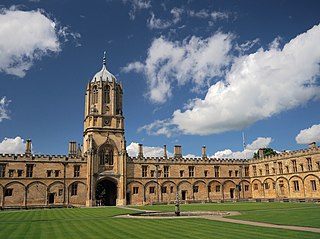
Christ Church is a constituent college of the University of Oxford in England. Founded in 1546 by King Henry VIII, the college is uniquely a joint foundation of the university and the cathedral of the Oxford diocese, Christ Church Cathedral, which both serves as the college chapel and whose dean is ex officio the college head.

Lincoln College is one of the constituent colleges of the University of Oxford, situated on Turl Street in central Oxford. Lincoln was founded in 1427 by Richard Fleming, the then Bishop of Lincoln.

Oriel College is a constituent college of the University of Oxford in Oxford, England. Located in Oriel Square, the college has the distinction of being the oldest royal foundation in Oxford. In recognition of this royal connection, the college has also been historically known as King's College and King's Hall. The reigning monarch of the United Kingdom is the official visitor of the college.

St Peter's College is one of the constituent colleges of the University of Oxford and is located in New Inn Hall Street, Oxford, United Kingdom. It occupies the site of two of the university's medieval halls, dating back to at least the 14th century. The modern college was founded by Francis James Chavasse, former Bishop of Liverpool, opened as St Peter's Hall in 1929, and achieved full collegiate status as St Peter's College in 1961. Founded as a men's college, it has been coeducational since 1979.
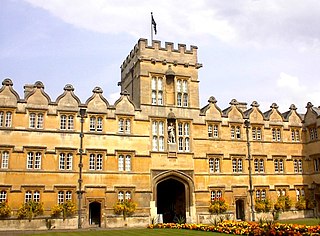
University College is a constituent college of the University of Oxford in England. It has a claim to being the oldest college of the university, having been founded in 1249 by William of Durham.

St Stephen's House is an Anglican theological college and one of six Permanent Private Halls of the University of Oxford, England.

Turl Street is a historic street in central Oxford, England.

The High Street in Oxford, England, known locally as the High, runs between Carfax, generally seen as the centre of the city, and Magdalen Bridge to the east.
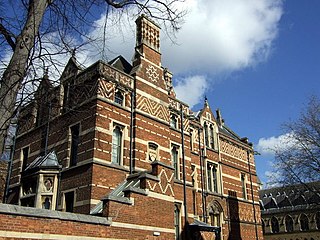
Museum Road is a short road in central Oxford, England. It leads to the Oxford University Museum of Natural History and the Radcliffe Science Library at its eastern end where it meets Parks Road. At its west end is a junction with Blackhall Road. It continues as the Lamb & Flag Passage past the Lamb & Flag public house on St Giles', a meeting place of J.R.R. Tolkien and the Inklings.

The Bear is a pub in Oxford, England, that was founded in 1774 as The Jolly Trooper. It stands on the corner of Alfred Street and Blue Boar Street, opposite Bear Lane in the centre of Oxford, just north of Christ Church, on the site of St Edward's churchyard. It was converted from the early 17th century residence of the stableman (ostler) for the coaching inn, The Bear Inn, which was on the High Street, Oxford. When The Bear Inn was converted into private housing in 1801, The Jolly Trooper changed its name to The Bear. There is a claim that by adopting its name, the current (1774) Bear Inn has acquired the history of the pub on the High Street, and so is one of the oldest pubs in Oxford. In 1952 the then landlord, Alan Course, started a collection of tie ends; a selection of the over 4,500 ties are on display around the pub. The tie collection was used as part of the plot of Colin Dexter's novel Death Is Now My Neighbour, in which Inspector Morse consults the landlord in order to identify a club tie. The building was Class II listed in January 1954.

Alfred Street is a street running between the High Street to the north and the junction with Blue Boar Street and Bear Lane at the southern end, in central Oxford, England. To the south is Christ Church, one of Oxford University's historic colleges.

Blue Boar Street is a narrow historic street running between St Aldate's to the west and the southern end of Alfred Street to the east, in central Oxford, England. It is located just north of Christ Church.
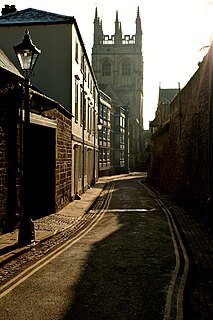
Magpie Lane is a narrow historic lane in central Oxford, England. It leads south from the High Street where it is at its narrowest, now completely pedestrianised as a pavement, and north from the cobbled Merton Street.

Market Street is a street in central Oxford, England, running east to west.
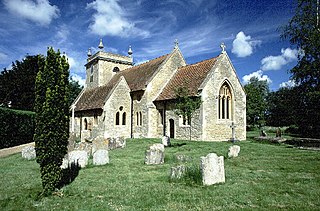
Stadhampton is a village and civil parish about 7 miles southeast of Oxford in South Oxfordshire, England. Stadhampton is close to the River Thame, a tributary of the River Thames. The village was first mentioned by name in 1146, and was in the ownership of the bishops of Lincoln, the crown, and various Oxford colleges for most of subsequent history. The village includes several buildings of historical and architectural interest, including a parish church with features dating back to the 12th-century.

Imperial College London's student accommodation comprises 23 halls of residence around West London, primarily South Kensington and North Acton. Accommodation is primarily for first-year undergraduates, although some halls exist for returning students, who may also return as "hall seniors" with operational responsibilities. Halls are run by wardens and subwardens, who are postgraduates or junior academics. Silwood Park halls are postgraduate, but only cater for students studying on site.
Vine Hall was an academic hall of the University of Oxford, located on Alfred Street in the 16th century. It became a part of the Peckwater Quadrangle of Christ Church, Oxford. The building gave its name to the previous name for Alfred Street, particularly the southwards continuation of it; Vine Hall Lane. Some have said that the current name Alfred Street is of unknown aetiology and pointless, and the street should be renamed Vine Hall Lane. It was previously known as St Edward's Lane, but the name Vine Hall Lane was in use by 1576.

The main buildings of Jesus College, one of the colleges of the University of Oxford, are located in the centre of the city of Oxford, England, between Turl Street, Ship Street, Cornmarket Street, and Market Street. Jesus College was founded in 1571 by Elizabeth I caused by the petition of a Welsh clergyman, Hugh Price, who was treasurer of St David's Cathedral. Her foundation charter gave to the college the land and buildings of White Hall, a university hall that had experienced a decline in student numbers. Price added new buildings to those of White Hall, and construction work continued after his death in 1574. The first of the college's quadrangles, which includes the hall, chapel, and principal's lodgings was completed between 1621 and 1630. Construction of the second quadrangle began in the 1630s, but was interrupted by the English Civil War and was not completed until about 1712. Further buildings were erected in a third quadrangle during the 20th century, including science laboratories, a library for undergraduates, and additional accommodation for students and fellows. In addition to the main site, the college owns flats in east and north Oxford, and a sports ground.

Brewer Street is a historic narrow street in central Oxford, England, south of Carfax. The street runs east-west, connecting with St Aldate's to the east and St Ebbe's Street to the west.




















